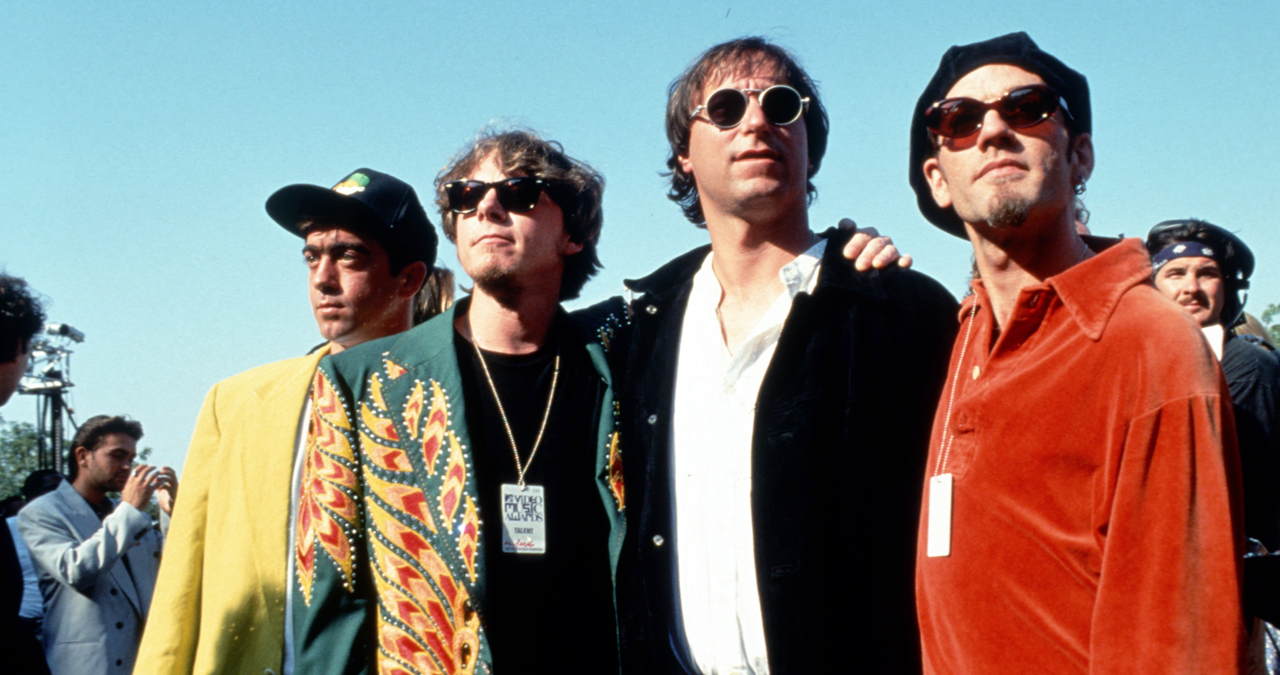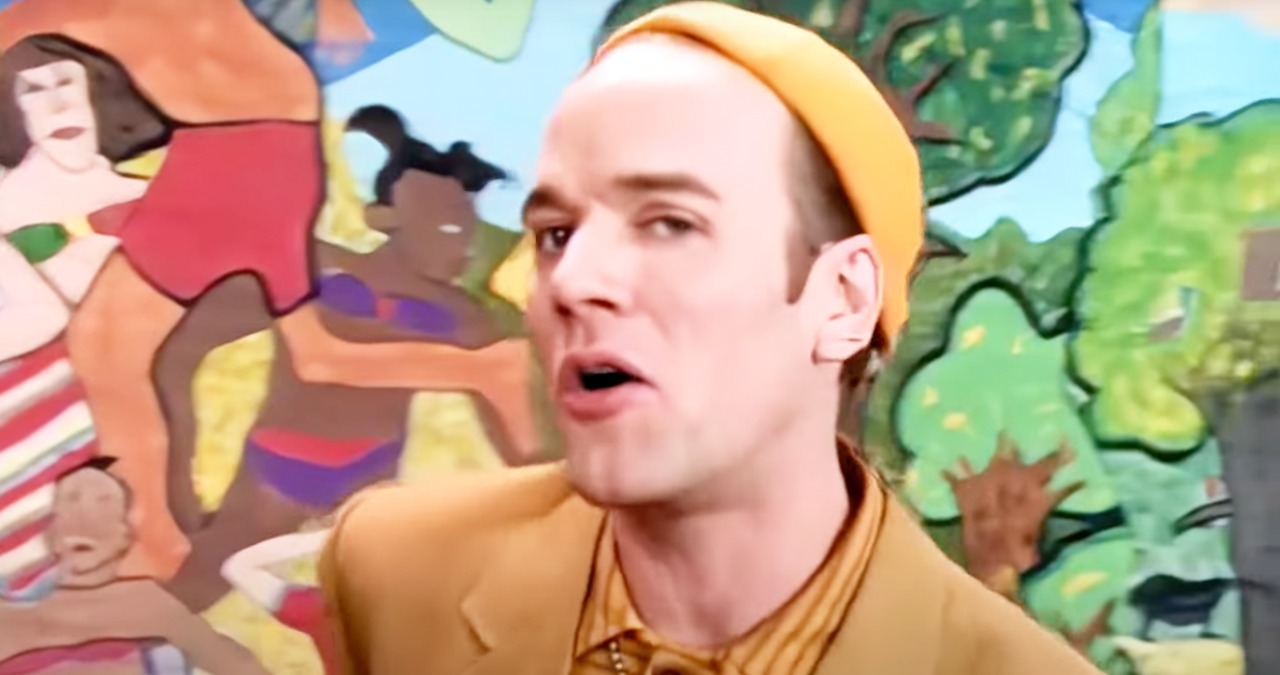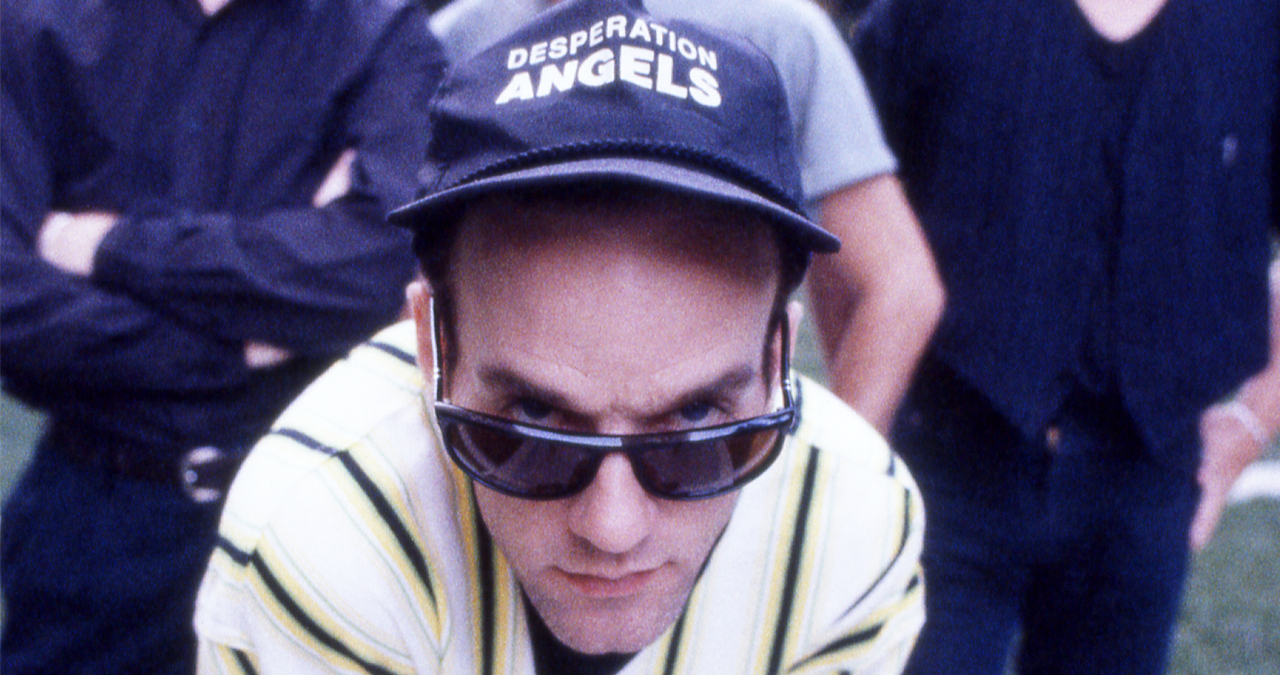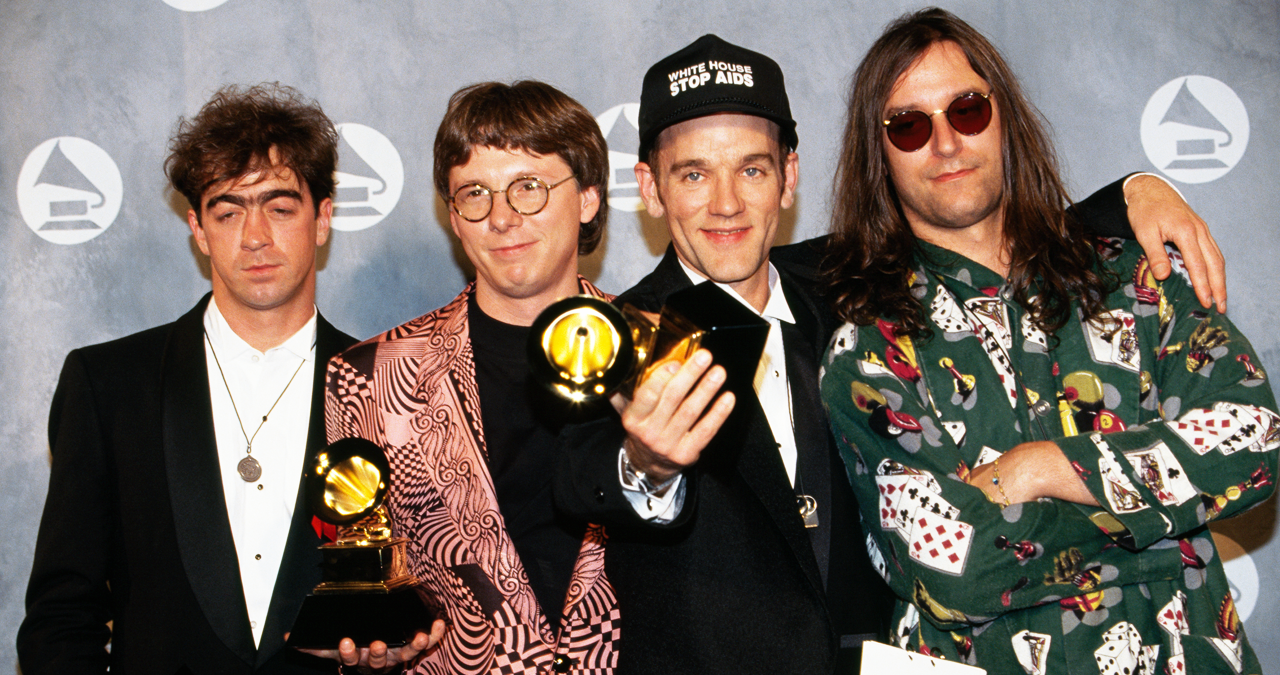“The band provided me with this ridiculous music and I had to, of course, kind of step up to it”: The enduring appeal of the REM radio smash that Michael Stipe hated
The song was inescapable in the early 1990s, yet the shifting dynamics and sunny lyrics of REM's upbeat smash continue to provoke questions about its true meaning

REM was never a band that adhered to a strict formula, but while many of their fans adored the inventive Athens, Georgia quartet for their deep and characterful songwriting, some would be left bewildered by the follow-up to arguably their greatest ever single with a cheery, radio-angled slice of unadulterated pop.
That single, which REM’s frontman Michael Stipe subsequently admitted had been written ‘for children’, was a deliriously upbeat tune titled Shiny Happy People.
With its angular riff, energetic, pogo-inducing beat and irresistible backing vocals from the B-52’s Kate Pierson, Shiny Happy People delighted and appalled listeners in equal measure.
But this buoyant riposte to the existential anguish of Losing My Religion seemed, to some at least, to be a test.
Here was this most artful (and political) of bands seemingly inviting their faithful to dig deeper and search for a darker subtext within this vibrant hit, whilst also getting away with a hefty commercial win via some unprecedented radio play.
With its Chinese Communist Party-inspired title, the oddness of its arrangement subverting the norms of pop songwriting, and a video that seemed to wallow in a state of transfixed mania, many fans believed that they had Shiny Happy People cracked.
But the truth is not so clear cut…
Written during the initial sessions for REM’s hugely successful 1991 album Out of Time in their home city of Athens during 1990, the framework of Shiny Happy People emerged in rapid time compared to the other tracks that would appear on their chart-topping seventh LP.
That repetitive, jangling riff came courtesy of guitarist Peter Buck, while its bouncy, 124bpm meter marked it out as an immediate oddity compared to the likes of the more forlorn Low or the regretful Half a World Away also penned during this period.
“We came up with the music and were all laughing about it,” Peter Buck told Rolling Stone. “When we recorded it, we just thought, ‘Ah, whatever.’"
Want all the hottest music and gear news, reviews, deals, features and more, direct to your inbox? Sign up here.
Chief lyricist and vocalist, Michael Stipe was humoured yet enthralled by Buck’s hypnotic riff, and felt suitably triggered to match its rosy tone with a lyric that outdid it in the unrelenting positivity stakes.
Born in Decatur, Georgia in 1960, Stipe, was the eldest child in his family household (with one younger sister) and was junior to his bandmates, Peter Buck, bassist Mike Mills and drummer Bill Berry.
Not having an elder sibling to turn him on to the nascent rock scene, or increasingly creative bands like the Beatles and the Beach Boys, Stipe’s formative years were instead spent transfixed by the uber-positive fare of commercially-aimed groups such as the Monkees and children's musical television shows such as the Banana Splits and the Archies.
Now 30 years-old, a reflective Stipe channeled those early influences into the writing of the song. “[Shiny Happy People] was my attempt at writing bubblegum pop music for kids,” Stipe admitted to Today.
In fact, it seems that Peter Buck and Mike Mills believed that their merry little musical ditty would pose a challenge to their typically nuanced and often verbose lyricist. However Stipe had found the perfect angle on which to approach the task; if you can't beat 'em, join 'em.
“The band provided me with this ridiculous music and I had to, of course, kind of step up to it and try to elevate it even more into the absurd,” Stipe told NBC’s Today programme. “I came back with Shiny Happy People.”
Stipe kept his words secret until it came time to lay down his vocal.

Initial recording of the track took place in John Keane’s Studio. This local Athens studio legend being a reliable desk jockey for the band ever since their third album, 1985's Fables of the Reconstruction.
When it came to Shiny Happy People, Keane recalled to TIDAL that; “I distinctly remember when we were all in the control room and Michael went in to sing the lyrics. None of the band members had actually heard the lyrics clearly until that point. When he got to the Shiny Happy People part, Mike Mills and Pete looked at each other like, ‘Really? Is that what he’s gonna sing?’ And then they hit the floor laughing.”
Shiny Happy People’s almost unbearable optimism feels like it's dripping with irony, with its first verse alluding to a euphoric, communal gathering:
“Meet me in the crowd
People, people
Throw your love around
Love me, love me
Take it into town
Happy, happy,
Put it in the ground, where the flowers grow”
Then, the song vaults into its chorus, and the repeating, almost cloying refrain,
“Shiny happy people holding hands
Shiny happy people holding hands”
The uncomplicated, almost Hallmark simplicity of Stipe’s words was a far cry from the man who'd scribed the frothing, paranoid nihilism of the punkish It’s the End of the World as We Know It just a few years prior.
Its naive platitudes and allusions to crowds, love and unity conjured the ghost of the 1960s peace movement, especially when wedded to Buck’s retro, Byrds-recalling riff.
Even Stipe’s fellow band members felt like he was masking something much more complex beneath his sunny lyrics.

The feeling that more was going on within Shiny Happy People was underscored by the stately, waltz-time string motif which both began the track, and resurfaced again during the track’s bridge. It seems to have nothing to do with the surrounding song, serving as an ocean of calm - a parallel pocket universe of restrained contentment.
Buck stated that he wanted this lush section to evoke the smooth groove of Chicago’s slick 1972 song Saturday in the Park. A gentle breath before the song bounces into the animated guitar motif and the more conventional 4/4 beat.
The divine string section (arranged by Mark Bingham), weaves between Buck's gradual chord progression from G, Em, Bm and C with stately class. Though the sudden time jump into the song’s intro (actually its chorus) is a jarring switch, it provides a necessary introduction to the track and a much needed step back during the song’s bridge, ahead of a final dynamic sprint to the finale.
It wasn’t just Shiny Happy People that marked a change during this period of songwriting for REM. Across Out of Time, more diverse instrumental and arrangement choices were being deployed at every turn.
Shunning more conventional electric instruments during the writing sessions, Buck’s prominent use of mandolin on Losing My Religion and the soaring Belong added a folksier dimension to REM's sound, while Mike Mills switch to keyboards and piano carved out a refreshed musical direction when building their strongest crop of music to date.
Another change to the norm was to, for the first time, invite another vocalist into the sessions.
For Shiny Happy People, that essential female backing vocal came from B-52’s vocalist Kate Pierson, herself also an Athens native and a good friend of Stipe.
Decamping for the final Out of Time sessions with longtime producer Scott Litt to Prince’s legendary Paisley Park studios in Minnesota, Pierson recalled that, after agreeing to contribute to the record, she was quite unprepared for just precisely how she’d tackle this garishly cheery cut.
“They sent me a demo before I traveled to the studio to see them. I didn’t really have time to plan anything. They didn’t give me any plan or map with what they wanted with the direction,” Pierson told Vulture. “When I got to Paisley Park they played the record. They’d already laid down Michael’s vocals and had pretty much everything recorded. They said, ‘Do whatever you want. Everything I did was as it is. And it was so refreshing to be able to be used that way.”
The natural spontaneity of Pierson’s overjoyed vocal responded to Stipe, with her radiant voice countering the more weathered tone of Stipe’s brilliantly.
“I was locked into Michael’s vocals. I love his voice and I think ours go really well together; they both have an edge that compliments each other well.”

Having decided to forego touring Out of Time, REM instead opted to concentrate on music videos and strategic appearances to promote their new record. This approach paid off with the widely shown (and soon to be iconic) videos for Losing My Religion and Shiny Happy People, both of which were central to both singles’ eventual success.
In the Shiny Happy People video, Stipe, clad in a backward baseball cap (which he had quickly grabbed from home), could have been mistaken for a children’s television show presenter, performing the song on what appears to be at TV show set with uncharacteristic elation.
Pierson was also front and centre during the video, vamping with Stipe alongside a troupe of dancers and supporting actors who, by the song's finale, engage in some energetic choreographed dance moves.
Song aside, it's fair to say that the video certainly does have a darker shade to it, as behind the scenes, an old man tirelessly keeps the show’s backdrop moving by cycling on an exercise bike.
Not the shiniest, or happiest of jobs…
The video’s director, Katherine Dieckmann told Entertainment Weekly that the idea for the video was a cross between Coca-Cola’s iconic 1970s ad ‘I’d Like to Teach the World to Sing’ and an old 1948 movie called ‘Letter From an Unknown Woman’.
“[In the film] a couple goes to a carnival with a railroad car attraction. Rotating landscape backdrops roll past their ‘window,’ and eventually we learn they’re propelled by an old man pedalling a stationary bicycle behind the scenes. I wanted to re-create this situation, but using a large children’s painting for the moving mural. Michael suggested I contact a mutual friend of ours, April Chapman, a schoolteacher in REM’’s hometown, Athens, and have her fifth-grade class create the backdrop.”
The video brought the song’s fevered energy to the fore, as well as its utopian spirit. Its constant rotation on MTV did much to drill the central melody in listener’s brains, as did utterly relentless radio play.
And so, in May 1991, Shiny Happy People landed in the top 10 of the US Billboard Chart and hit number six in the UK chart.
Though instantly popular with the record-buying public, Shiny Happy People's childish energy rankled die-hard REM followers. In an era when 'selling-out' was perceived as the cardinal sin, some were aghast at the band’s decision to jettison the overt intellect and nuance of their previous work.
With alternative rock's tone becoming increasingly tortured and raw, many outright rejected the song, while others believed that REM’s overwhelmingly optimistic new number simply must be shrouding denser layers.

This theory was evidenced by the fact that the phrase ‘shiny happy people holding hands’ had seemingly been seen emblazoned on CCP propaganda posters following the horrific massacre in Tiananmen Square in 1989. That was something that the politically conscious Stipe was obviously very aware of.
So, was Stipe's song a not so-subtle dig at authoritarianism disguised as the sort of lightweight, thoughtless fluff that such a regime might accept?
Stipe, nor the band, have ever confirmed or denied the Tiananmen Square correlation, despite many outlets still publishing this reading as fact.
Instead, Stipe has remained plainly adamant that Shiny Happy People is genuinely what it appears to be on the tin - a happy, uplifting song aimed squarely at children and the young at heart.
Stipe made this point clearly in a 2011 interview with The Quietus.When asked what the song was meant to be, Stipe responded, “Exactly what it is. Which is a really fruity, kind of bubblegum song."
The song's popularity was such that the producers of a brand new sitcom, called Friends, approached the band a couple of years after its release and asked if it could be used as the show’s main theme. REM, at that point having grown tired of Shiny Happy People's already oversized cultural footprint, rejected their request.
But the show's producers penned their own attempt at copying the Shiny Happy People mould, and asked Warner Brothers' band the Rembrandts to turn their lyrics into a song with a similarly exuberant pace and 60's-leaning feel. That song would, of course, become the even more ubiquitous I’ll Be There For You.
“They went to another band and said, ‘Can you write an REM song?’” Stipe recalled in an interview with NME. “That’s what I’ve heard. I don’t want to diss the other band. I don’t remember who they are, but that’s a good song.”
Over the years, REM struggled with the overexposure of Shiny Happy People, arguably their least representative song, in the popular culture canon.
In recent years, however, Stipe has come to terms with its enduring appeal, while acknowledging the polarising effect it still has on their fan community.
“I was always at peace with it.” Stipe told The Quietus. “It’s just a little bit embarrassing that it became as big a hit as it did!”

I'm Andy, the Music-Making Ed here at MusicRadar. My work explores both the inner-workings of how music is made, and frequently digs into the history and development of popular music.
Previously the editor of Computer Music, my career has included editing MusicTech magazine and website and writing about music-making and listening for titles such as NME, Classic Pop, Audio Media International, Guitar.com and Uncut.
When I'm not writing about music, I'm making it. I release tracks under the name ALP.
You must confirm your public display name before commenting
Please logout and then login again, you will then be prompted to enter your display name.